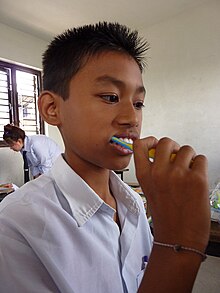Oral hygiene
Oral hygiene is the care of the teeth, gums, tongue and the entire oral cavity in general. It is established by adopting four habits: brushing, flossing, rinsing, and regular visits to the dentist and dental hygienist. It is also important to control the intake of certain foods, especially those that have a high cariogenic potential, especially sugars, such as sucrose or glucose, and to avoid unhealthy habits such as cigarettes. The most dental-stomatological problems and diseases Frequently due to incorrect or insufficient oral or dental hygiene are: Excessive development of bacterial plaque, formation of tartar, halitosis, caries, gingivitis and periodontitis.
Brushing
Good oral hygiene begins with proper brushing, which should be done right after each meal, intake of beverages, especially sugary and carbonated beverages, sweets or snacks, or any food. The most important brushing, and the one that should not be missed, is after dinner or before bed.
However, excessive brushing can lead to early wear of the enamel, especially if citrus fruits have been ingested after meals, so the ideal is between two and three daily brushings.
It may also be advisable to brush before meals to reduce plaque bacteria. It is recommended to brush your teeth for a time of three to five minutes; that is, ten brushings for every two teeth. Preferably it should be with a medium brush, with bristles and a straight handle and with a toothpaste that contains sodium fluoride. It is important to emphasize that the dentist is the one who must assess how the oral hygiene of each patient should be according to her needs. The use of chewing gum may be advisable. The action of chewing stimulates the secretion of saliva, which prevents the pH of the mouth from becoming excessively acidic. Xylitol inhibits the growth of streptococcus mutans bacteria, which causes cavities. These gums do not replace the benefits of brushing.
Brushing should be done by introducing the bristles of the brush into the space formed between the teeth. You should also brush the inside of the cheeks, tongue, palate and gums, if they are healthy. There are sores that can be remedied by rinsing with salt water. In case of observing any anomaly, it is necessary to go to the specialist.
Healthy gums don't bleed when brushing. If obvious bleeding is observed with normal brushing, it is likely that it is a case of gingivitis; especially if it is habitual (if it is only sporadic, it is probably a question of applying excessive force when brushing). The solution is simple: go to a dentist or stomatologist to evaluate the situation and, if necessary, clean the gingivo-dental space. It is recommended that this professional cleaning be carried out periodically. Oral hygiene has been essential for health and well-being.
Correct tooth brushing technique
- Place the stitching on the gum at an angle of 45 degrees. Waxes should be in contact with the dental surface and gum.
- Gently brush the external dental surface of two or three teeth with a sweeping motion from the front to the back. Move the brush to the next group of two or three teeth and repeat the operation.
- Keep an angle of 45 degrees with stitches in contact with the dental surface and gum. Cepille gently using a sweeping motion and at the same time make a forward backward motion over the entire internal surface.
- Incline the brush vertically behind the front teeth. Make several moves up and down using the front part of the brush.
- Put the brush on the chewing surface and make a smooth move forward backwards. Don't forget to brush your tongue back too to remove the bacteria that cause bad breath.
- 2 minutes is the amount of time needed to be able to pass it through the inner face, the external, the molars and the tongue.
The toothbrush should be changed every two or three months, depending on the state of the brush.
Ultrasonic electric toothbrushes can make this task easier.
Flossing
It is also recommended to clean the interdental spaces with floss, at least once a day, using a different part of the floss for each space. The impossibility of introducing the silk between the dental pieces is rare. If this happens, you should consult your dentist or stomatologist, it could be dental calculus deposits that can only be removed by a professional.
The Rinse
After brushing and flossing, rinsing with a mouthwash may be convenient, especially in case of gingivitis. Mouthwashes with chlorhexidine appear to have significant antibacterial activity.
It is not recommended to abuse the mouthwash; that is to say, it is especially indicated for the elimination of bacterial plaque and periodic maintenance, but abusing it can be totally counterproductive for the protection of dental enamel.
In addition, mouthwashes partially eliminate bacteria from the mouth, both the harmful ones and the beneficial ones they defend, leaving the mouth vulnerable for some time.
Always make sure that mouthwashes do not contain alcohol, since it has been shown that the abuse of these products increases the probability of contracting oral cancer.
Should be used twice a day.
For its part, mouthwash can help fight bacteria that cause bad breath, dental plaque and tartar and can be used after brushing to help remineralize tooth enamel, especially if it contains sodium fluoride.
Contenido relacionado
Calcium carbonate
Huntington's disease
X fragile syndrome
